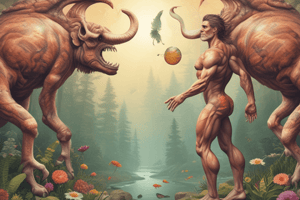Podcast
Questions and Answers
What is a key characteristic of vestigial structures?
What is a key characteristic of vestigial structures?
- They are fully developed and functional.
- They are structures that evolve rapidly in response to environmental changes.
- They serve essential functions for survival.
- They are remnants of structures that served a purpose in ancestors. (correct)
Which statement accurately describes cladistics?
Which statement accurately describes cladistics?
- It focuses on physical similarities among organisms only.
- It classifies organisms based on random traits.
- It does not consider evolutionary relationships.
- It groups organisms by common descent. (correct)
What occurs during coevolution?
What occurs during coevolution?
- Species evolve independently without influence from one another.
- A single species diversifies into multiple forms.
- Unrelated species adapt similarly to environmental conditions.
- Two species evolve together in response to each other. (correct)
What does the Hardy-Weinberg Principle describe?
What does the Hardy-Weinberg Principle describe?
Which statement correctly describes convergent evolution?
Which statement correctly describes convergent evolution?
What principle helps in dating fossil records by examining the depth of sedimentary layers?
What principle helps in dating fossil records by examining the depth of sedimentary layers?
Which radioisotope is commonly used to date fossils that are up to about 50,000 years old?
Which radioisotope is commonly used to date fossils that are up to about 50,000 years old?
Which mechanism of evolution is primarily described by the concept of 'survival of the fittest'?
Which mechanism of evolution is primarily described by the concept of 'survival of the fittest'?
What do transitional species provide evidence for in evolutionary biology?
What do transitional species provide evidence for in evolutionary biology?
Who is known for the significant work 'On the Origin of Species'?
Who is known for the significant work 'On the Origin of Species'?
What type of structures are homologous structures?
What type of structures are homologous structures?
What describes the process where species produce more offspring than can survive?
What describes the process where species produce more offspring than can survive?
What is the outcome of the concept 'descent with modification' in evolution?
What is the outcome of the concept 'descent with modification' in evolution?
Flashcards
Vestigial Structures
Vestigial Structures
Structures that once served a purpose in an organism's ancestors but are now reduced or non-functional.
Coevolution
Coevolution
The process by which two species evolve in response to each other's changes.
Divergent Evolution
Divergent Evolution
A single species evolving into multiple forms that adapt to different environments.
Convergent Evolution
Convergent Evolution
Signup and view all the flashcards
Artificial Selection
Artificial Selection
Signup and view all the flashcards
Law of Superposition
Law of Superposition
Signup and view all the flashcards
Radioisotope Dating
Radioisotope Dating
Signup and view all the flashcards
Transitional Species
Transitional Species
Signup and view all the flashcards
Mass Extinction
Mass Extinction
Signup and view all the flashcards
Lamarck's Theory
Lamarck's Theory
Signup and view all the flashcards
Natural Selection
Natural Selection
Signup and view all the flashcards
Descent with Modification
Descent with Modification
Signup and view all the flashcards
Mutations
Mutations
Signup and view all the flashcards
Study Notes
Evolution: Theories, Mechanisms, and Evidence
- Evolution describes species' gradual development over time through genetic changes.
- Law of Superposition: Lower sedimentary layers are older than higher ones. Crucial for dating fossil records.
- Radioisotope Dating: Measures radioactive decay in rocks to estimate fossil age. Uses isotopes like Carbon-14, Potassium-40, and Uranium-238.
- Transitional Species: Intermediate traits between older and younger species, showing gradual evolution.
- Mass Extinctions: Significant species loss in a short time. Examples include the Permian-Triassic and Cretaceous-Paleogene events.
- Jean-Baptiste Lamarck: Proposed evolution via inheritance of acquired characteristics (e.g., giraffes stretching necks).
- Charles Darwin: His "On the Origin of Species" introduced natural selection as the primary driver of evolution.
- Natural Selection:
- Overproduction: More offspring produced than can survive.
- Genetic Variation: Individuals vary in traits.
- Adaptation: Favourable traits become more common.
- Struggle to survive: Competition for resources.
- Differential reproductive success: Some reproduce more effectively.
Principles and Mechanisms
- Descent with Modification: Species evolve from ancestral species.
- Mutations and Selective Pressure:
- Mutations: DNA changes, can be beneficial, harmful, or neutral.
- Selective Pressure: Environmental factors favour certain traits.
- Homologous Structures: Similar structures in different species from a common ancestor.
- Vestigial Structures: Structures with reduced function, inherited from ancestors.
- DNA and Evolution: Similarities in DNA show evolutionary relationships.
- Cladistics: Organism classification based on shared ancestry.
Patterns in Evolution
- Coevolution: Species evolve in response to each other's changes.
- Divergent Evolution (Adaptive Radiation): One species evolves into many forms adapted to varied environments.
- Convergent Evolution: Unrelated species develop similar traits in similar environments.
- Analogous Structures: Similar functions but different origins (e.g., bird and insect wings).
Human Influence
- Artificial Selection: Humans breed organisms for specific traits.
- Sexual Selection: Traits increasing mate attraction are favoured.
- Population Genetics:
- Hardy-Weinberg Principle: Allele frequencies remain constant in stable populations if no specific influencing factors affect them.
Studying That Suits You
Use AI to generate personalized quizzes and flashcards to suit your learning preferences.




